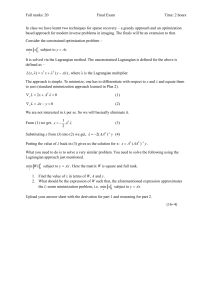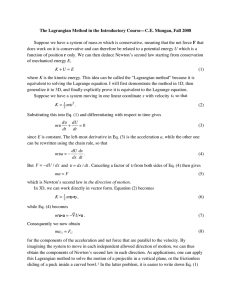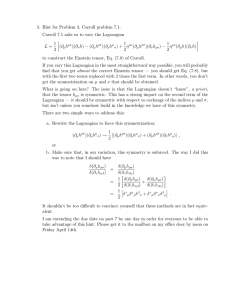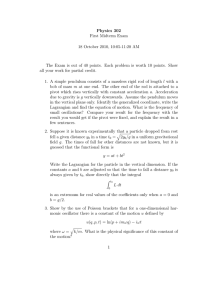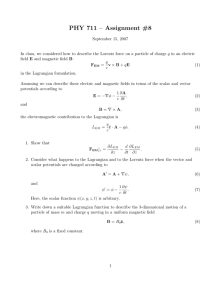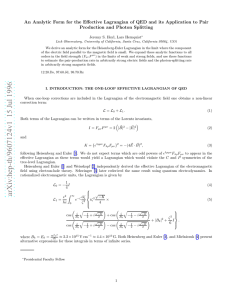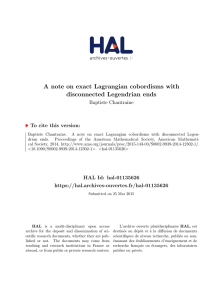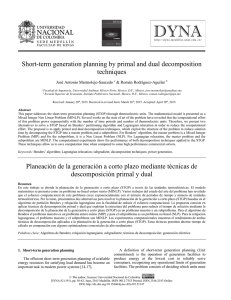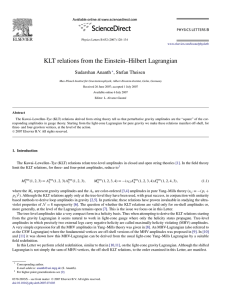Physics 321 Hour 16 Lagrangian Dynamics
advertisement
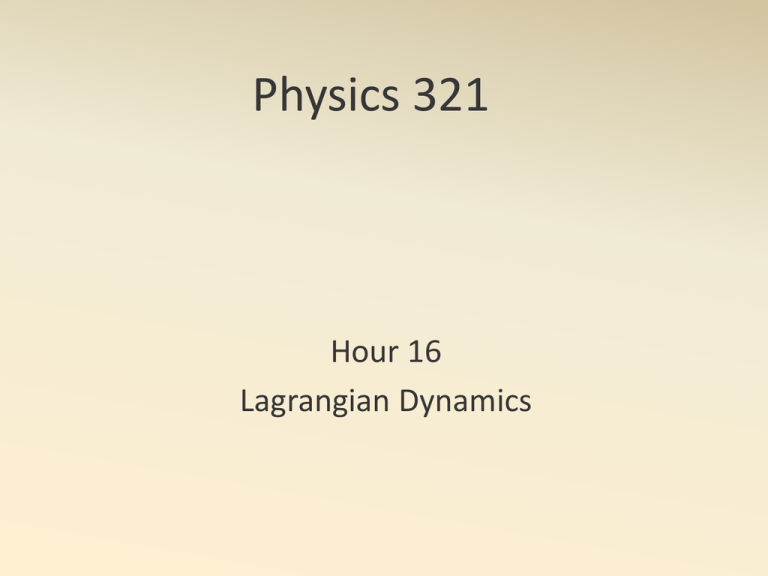
Physics 321 Hour 16 Lagrangian Dynamics Bottom Line • The Lagrangian is defined as ℒ = 𝑇 − 𝑈 • When we minimize the “action integral” 𝑡2 𝑆= ℒ 𝑥, 𝑥, 𝑡 𝑑𝑡 , 𝑡1 the value of x(t) that is given is the actual motion of an object. • This means that 𝜕ℒ 𝑑 𝜕ℒ = 𝜕𝑥 𝑑𝑡 𝜕𝑥 • This is all magic. Changing the Names… 𝑡2 𝑆= ℒ 𝑥, 𝑥, 𝑡 𝑑𝑡 𝑡1 S is an extremum (so varying the path a little does not change S) if 𝜕ℒ 𝑑 𝜕ℒ = 𝜕𝑥 𝑑𝑡 𝜕𝑥 Changing the Names… 𝑡2 𝑆= ℒ 𝑥, 𝑥, 𝑡 𝑑𝑡 𝑡1 Is there a function ℒ such that S is stationary for the actual 𝑥(𝑡) chosen by nature? -- Comparison with results from “standard” Newtonian mechanics shows that there is! The Lagrangian 𝑡2 𝑆= ℒ 𝑥, 𝑥, 𝑡 𝑑𝑡 𝑡1 S is called the “action integral” and ℒ is the “Lagrangian” ℒ =𝑇−𝑈 Using The Lagrangian • Find the kinetic and potential energies • Construct the Lagrangian ℒ =𝑇−𝑈 • Use Lagrange’s Equation 𝜕ℒ 𝑑 𝜕ℒ = 𝜕𝑥 𝑑𝑡 𝜕𝑥 • We never need to consider the action integral Using The Lagrangian • Variable = 𝑞 (like 𝑥 or 𝜃) • Generalized momentum (like 𝑝 or 𝐿) 𝜕ℒ 𝑝= 𝜕𝑥 • Lagrange’s Equation 𝑑 𝜕ℒ 𝜕ℒ = 𝑑𝑡 𝜕𝑥 𝜕𝑞 can be written 𝜕ℒ 𝑝= 𝜕𝑞 Using The Lagrangian 𝜕ℒ 𝑝= 𝜕𝑞 In a simple case 𝑝 is the force as is 𝜕ℒ 𝜕𝑞 = 𝜕𝑈 − 𝜕𝑞 Examples A mass m falls freely A mass m is acted on by a spring with constant k (no gravity) Add gravity Add friction The Lagrangian and Mathematica pendulum.nb spring pendulum.nb parabolic bowl.nb
